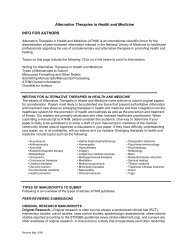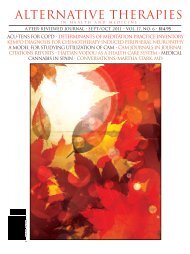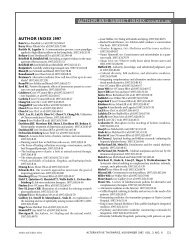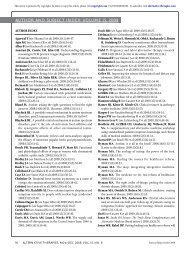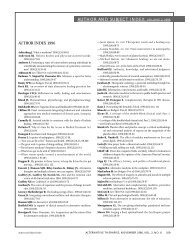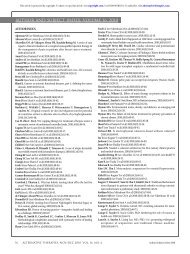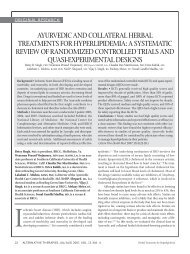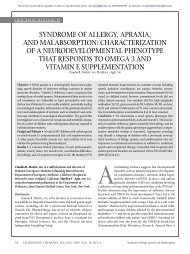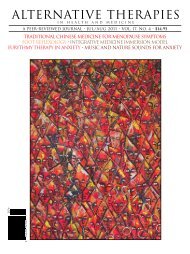Alternative Therapies In Health And Medicine
Alternative Therapies In Health And Medicine
Alternative Therapies In Health And Medicine
Create successful ePaper yourself
Turn your PDF publications into a flip-book with our unique Google optimized e-Paper software.
study in the decrease in Kupperman score by acupuncture and HT<br />
but does not confirm it with regard to E2. Furthermore, no significant<br />
difference between HT group and acupuncture group was identified.<br />
A study by Tian and Zhang showed better results for a<br />
combination of herbs and acupuncture (97%) vs HT (73%), which<br />
does not coincide with the results of this study indicating the same<br />
efficacy for both of these groups. 22<br />
<strong>In</strong> Chinese medicine, menopausal problems are fundamentally<br />
due to a decline of kidney essence, which can take the form of kidney<br />
yin, kidney yang, or a combined deficiency of kidney yin and kidney<br />
yang. <strong>In</strong> this study, only patients with a syndrome of decline in the<br />
yin of kidney and liver accompanied by hyperactivity and rising of<br />
liver yang were admitted as participants. This syndrome is characterized<br />
by red tongue without fur. According to traditional principles of<br />
treatment, these patients needed to receive herbs to nourish their yin<br />
of kidney and liver, subdue the yang of liver, and calm the mind, so<br />
the formulation of KBW was chosen. KBW has been formulated on<br />
the basis of the classic theories of traditional Chinese medicine and<br />
previous animal experiments. <strong>In</strong> the formula of KBW, Fructus Ligustri<br />
Lucidi, Radix Paeoniae Lactiflorae, and Radix Rehmanniae were chosen<br />
as the monarch drugs, meant to nourish the yin of liver and kidney. 26-28<br />
Flos Chrysanthemi Morifolii and Radix Scutellariae Baicalensis help to<br />
subdue liver yang. Semen Zizyphi Spinosae subdues the yang of liver<br />
and calms the mind. 26-28 New research about the primary herbs<br />
shows their various benefits for women in peri- and postmenopause.<br />
Many recent studies suggest that Fructus Ligustri Lucidi 29-33 and Radix<br />
Paeoniae Lactiflorae 34 are useful as an alternative medicine for improving<br />
calcium balance and preventing osteoporosis in postmenopausal<br />
women, which is in accordance with the traditional Chinese medicine<br />
theory on nourishing the kidney yin. The extract of Fructus<br />
Ligustri Lucidi improves calcium balance, modulates the calciotropic<br />
hormone level, and increases vitamin D–dependent calcium transport<br />
in aged ovariectomized rats. 30 Whereas Fructus Ligustri Lucidi<br />
did not show estrogenic effects in the research by Zhao et al, 35 Radix<br />
Rehmanniae is reported to have certain phytoestrogenic effects in one<br />
study. 36 More investigations are necessary to clarify these effects.<br />
This study found a significant decrease in clinical symptoms as<br />
reflected in the decrease of total Kupperman scoring and number of<br />
symptoms in all three therapies with no significant difference<br />
between HT and the other two traditional treatments, suggesting<br />
that herbal treatment and acupuncture may offer as much benefit as<br />
the conventional treatment (HT) without posing the risks that HT<br />
does. However, the group treated with acupuncture in conjunction<br />
with herbal medicine presented significantly better results than<br />
those receiving herbal medicine alone in controlling symptoms.<br />
Herbal treatment alone failed to decrease the level of FSH. This may<br />
suggest that the underlying mechanism of this formulation of medicinal<br />
herbs should not be estrogenic effects, a supposition that diminishes<br />
concerns about the risk of the phytoestrogenic properties of<br />
these herbs. Of course, this matter deserves more rigorous investigation.<br />
On the other hand, the decline in FSH resulting from the ACU +<br />
CHM treatment suggests a real physiologic effect in this group. One<br />
hypothesis states that the effectiveness of acupuncture in relieving<br />
menopausal symptoms may be due to the triggering of the release of<br />
hypothalamic ß-endorphin; another hypothesis points to the release<br />
of 5-HTP. A decrease in the activity of hypothalamic ß-endorphin<br />
and a decrease in the level of blood serotonin are considered two<br />
presumed pathways in the pathophysiology of menopausal vasomotor<br />
symptoms. Hypotheses concerning the acupuncture mechanism<br />
in alleviating menopausal symptoms need to be explored by future<br />
studies. Also, further studies with more control groups are recommended<br />
in order to better clarify and compare the effects of herbal<br />
medicine and acupuncture (eg, a clinical trial with acupuncture,<br />
sham acupuncture, herbal medicine, and HT groups).<br />
CONCLUSIONS<br />
This study reveals that the application of a combination of<br />
CHM and acupuncture is as effective as HT in the treatment of<br />
menopause-related symptoms and that it works better than herbal<br />
medicine alone. Chinese herbs together with acupuncture may be a<br />
useful alternative treatment for women suffering from menopausal<br />
symptoms and who are unable or reluctant to receive HT.<br />
Acknowledgments<br />
Authors of this article thank Yunzhi Chen, PhD, Xiaoyan Dou, MSc, Lu Liu, MSc, Muhammad Ali<br />
Rasaee, and Amir Hossein Sabouri, MD, for their sincere help, as well as the patients who contributed<br />
in the research. Hoda Azizi is thankful to Iran’s Ministry of <strong>Health</strong> and Medical Education for<br />
its support by presenting a scholarship to her for doctoral work at the Beijing University of Chinese<br />
<strong>Medicine</strong>. She is also grateful to Beijing University of Chinese <strong>Medicine</strong> for supporting her doctoral<br />
thesis (grant 2001201051550-10).<br />
REFERENCES<br />
1. No authors listed. NIH state-of-the-science conference statement on management of<br />
menopause-related symptoms. NIH Consens State Sci Statements. 2005;22(1):1-38.<br />
2. Cobin RH, Futterweit W, Ginzburg SB, et al; AACE Menopause Guidelines Revision Task<br />
Force. American Association of Clinical Endocrinologists medical guidelines for clinical<br />
practice for the diagnosis and treatment of menopause. Endocr Pract. 2006;12(3):315-337.<br />
3. North American Menopause Society. Estrogen and progestogen use in peri- and postmenopausal<br />
women: March 2007 position statement of The North American Menopause<br />
Society. Menopause. 2007;14(2):168-182.<br />
4. Boulet MJ, Oddens BJ, Lehert P, Vemer HM, Visser A. Climacteric and menopause in seven<br />
south-east Asian countries. Maturitas. 2008;61(1-2):34-53.<br />
5. Liu J, Eden J. Experience and attitudes toward menopause in Chinese women living in<br />
Sydney—a cross sectional survey. Maturitas. 2007;58(4):359-365.<br />
6. Umland EM. Treatment strategies for reducing the burden of menopause-associated vasomotor<br />
symptoms. J Manag Care Pharm. 2008;14(3 Suppl):14-19.<br />
7. Utian WH. Psychosocial and socioeconomic burden of vasomotor symptoms in menopause:<br />
a comprehensive review. <strong>Health</strong> Qual Life Outcomes. 2005 Aug 5;3:47.<br />
8. Williams RE, Kalilani L, DiBenedetti DB, Zhou X, Fehnel SE, Clark RV. <strong>Health</strong>care seeking and<br />
treatment for menopausal symptoms in the United States. Maturitas. 2007;58(4):348-358.<br />
9. Grodstein F, Stampler MJ, Colditz GA, et al. Postmenopausal hormone therapy and mortality.<br />
N Engl J Med. 1997;336(25):1769-1775.<br />
10. Adams C, Cannell S. Women’s beliefs about “natural” hormones and natural hormone<br />
replacement therapy. Menopause. 2001;8(6):433-440.<br />
11. Rossouw JE, <strong>And</strong>erson GL, Prentice RL, et al; Writing Group for the Women’s <strong>Health</strong><br />
<strong>In</strong>itiative <strong>In</strong>vestigators. Risks and benefits of estrogen plus progestin in healthy postmenopausal<br />
women: principal results from the Women’s <strong>Health</strong> <strong>In</strong>itiative randomized controlled<br />
trial. JAMA. 2002;288(3):321-333.<br />
12. Chen CL, Weiss NS, Newcomb P, Barlow W, White E. Hormone replacement therapy in<br />
relation to breast cancer. JAMA. 2002;287(6):734-741.<br />
13. Wang L, Cheng WD, Wang CX, Xu CF, Chen YQ. Meishen granules treated 30 cases of<br />
menopausal syndromes [article in Chinese]. New J Tradit Chin Med. 2008;40(10):59-60.<br />
14. Geng JW. Geng An Tang treated the menopause syndrome in 96 cases [article in Chinese].<br />
Chinese J Clin. 2002;50:46.<br />
15. Yan H. Kun Bao Wan treat menopausal symptoms of 36 cases [article in Chinese]. Zhong<br />
Guo Ming Jian Liao Fa. 2006;14:38-39.<br />
16. Qu F, Cai X, Gu Y, Zhou J, Zhang R, Burrows E, Huang H. Chinese medicinal herbs in<br />
relieving perimenopausal depression: a randomized, controlled trial. J Altern Complement<br />
Med. 2009;15(1):93-100.<br />
17. Zhou J, Qu F, Nan R, Tang D. The effect of Chinese medicinal herbs in relieving menopausal<br />
symptoms in ovariectomized chinese women. Explore (NY). 2007;3(5):478-84.<br />
18. Xia XH, Hu L, Qin ZY, et al. Multicentral randomized controlled clinical trials about treatment<br />
of perimenopausal syndrome with electroacupuncture of sanyinjiao (SP 6) [article in<br />
Chinese]. Zhen Ci Yan Jiu. 2008;33(4):262-266.<br />
52 ALTERNATIVE THERAPIES, jul/aug 2011, VOL. 17, NO. 4 Menopause: Traditional Chinese <strong>Medicine</strong> vs Hormone Therapy



